Touring the Ukraine
Churches, cathedrals and monasteries with golden domes
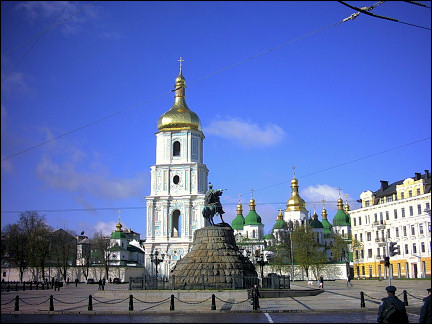
|
The Ukraine is easily traveled by train: Kiev with its churches and monasteries, Chernobyl wich still suffers from the effects of the nuclear disaster, Lviv with its museums and beautiful buildings, Odessa, which is a little disappointing, Yalta and the Crimea, where the czars built many palaces and where the Black Sea is always near. The country, with its long and suffering-drenched history, slowly begins to prosper again.
Travelogue: Ton Groothedde
Photos: Wil Deckers & Ton Groothedde
Kiev
Old churches and new clothes stores with expensive brands
When we leave the arrival hall at Boryspil International Airport, we are immediately surrounded by people who offer us accomodation and taxis. Boryspil is approximately 40 km east of the capital Kiev. After some negotiating, a taxi takes us to Hotel Ukraina in the city center of Kiev for 150 grivna.
The hotel sits on the central square Maydan Nezalezhnosti, at the end of Khreshchatyk, a wonderful shopping street with wide pedestrian areas. Everywhere are pedestrian underpasses, so one doesn't have to cross the busy road. On the weekends the street is closed to traffic.
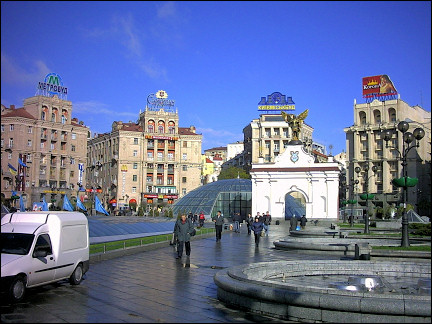
|
Small food stores, bars and restaurants are alternated with huge perfume and clothes stores, which sell expensive brands. Beautiful young Ukrainian women promenade their butts off in super-short skirts, even though it's freezing cold.
Lots of people are drinking beer in the streets, straight out of the bottle, sitting on benches or walking. In the evening many buildings on Khreshchatyk and Maydan Nezalezhnosti are beautifully illuminated. The many fountains create a pleasant atmosphere.
Communism may be a thing of the past, in terms of staff policy it's still alive and kicking. On every floor of the hotel, next to the elevator, sits a woman who manages the keys. By the door of the breakfast room is a lady who takes our breakfast card and hands it to the breakfast-card hole puncher. The next employee takes us to our table and the hole puncher returns our breakfast card with a neatly punched hole in it. Almost all tables are empty and some of the large staff are looking bored.
We walk via Maydan Nezalezhnosti and the underpass under shopping street Khreshchatyk to Sofiskaya Street and the adjoining square, where we take a look at the light-blue and white St. Sophia cathedral with its gold and green domes.
The cathedral is 37 meters long, 55 meters wide and 29 meters high. The interior is beautiful with its darkish colors. It has many frescoes, mosaics and sarcophaguses, most dating from the 10th and 11th centuries. A large sarcophagus belongs to King Yaroslav the Sage, who commissioned the cathedral, which was built between 1017 and 1031.
We cross the huge Sofiyska square and pass the statue of Bohdan Khmelnytsky, a Cossack chief who fought for an independent Cossack state in the first half of the 17th century, but who also incited and led pogroms in which thousands of mostly poor Jews were murdered.
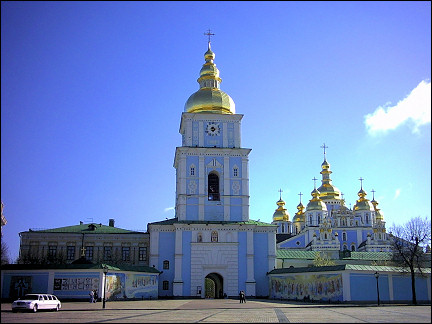
|
After crossing the square we soon find ourselves face to face with the impressive St. Michael monastery. A blue tower with a golden dome serves as entrance. The most remarkable part is a big blue building with seven golden domes.
We take a cable car to the banks of the Dnjepr and walk along the river, looking for the Chernobyl museum. There, we mainly look at pictures, not only because there are so many, but also because none of the explaining texts has been translated into English.
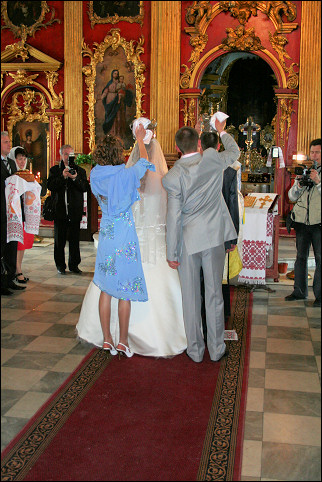
|
We walk to nearby Andriyivsky uzviz, a pleasant street with cobblestones, which rises steeply and has souvenir stalls on both sides, selling babushkas, necklaces, wooden dolls, gems ans shirts.
The street connects the lower-lying district Podil and the Dnjepr banks with the higher-lying part of Kiev. At the top of the hill sits the pretty, blue-and-white St. Andrivy (Andrew) church with its gold and green domes.
A wedding ceremony is in progress. The minister sings his lungs out, while the bridal couple walk three times around the altar. Behind the bride is a woman who holds a silver crown over her head. Behind the groom walks a man who does the same thing for the groom.
Chernobyl
Bumping in an old Lada to the site of the disaster
I have booked a trip to Chernobyl at a Ukrainian travel agent. Now that I have the opportunity, I want to visit the location of the nuclear disaster to get an idea of its impact.
We see one after another luxury car pass and every time we say "that must be our taxi." After all, Chernobyl is approximately 140 km from Kiev, near the White- Russian border, so comfortable transportation is not an unnecessary luxury.
But then an ancient and decrepit Lada drives up to us. The driver gets out and asks if we are mister Ton and mister Wil. When we reach the highway, creaking and squeaking, it becomes clear that the trip is going to take a while. The Lada can't go faster than 80 k/p/h; and thus we bump toward Chernobyl. It has its charms.
We drive through villages where many people sell merchandise on the side of the road, like a bucket of potatoes. The farther we get from Kiev, the less fancy cars we see and eventually the only cars on the road are brands like Lada, Volga, NSU and Wartburg.
We pass towns like Teterev and Ivankiv. All pine tree trunks are red up from 2 m above the ground. We see horse-drawn wagons all the time now, even plowing the land is still done with horse-and-plow.
Tens of kilometers before we reach Chernobyl, there is no motor traffic in sight anywhere. The amount of dilapidated houses increases visibly. We pass abandoned hamlets, where all houses are overgrown by bushes and shrubs.
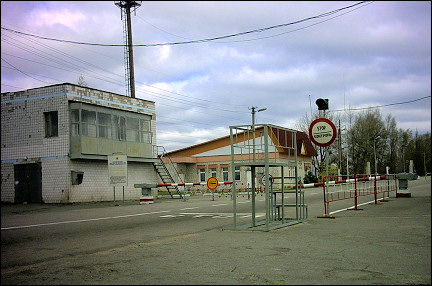
|
At a checkpoint we have to hand over our passports. After a while we are allowed to continue. We pass an increasing number of memorials and a larger village in which all houses are also completely overgrown.
Chernobyl itself looks also deserted, but soon it turns out that people work here, among them Dennis, our guide for the day, who is dressed in military uniform and speaks English very well. We are received in, mind you, "State Enterprise 'Agency of Information, International Cooperation and Development ChornobylInterInform'". Here we have to sit down in a radiation measuring device: a green light means acceptable, a red light unacceptable levels of radiation.
Dennis gives us a tour, explaining the 1986 disaster, what caused it, the impact, the contaminated zones, the amount of radio-active waste, etc. Most radio activity fell out in the Chernobyl region and in White Russia, which was in the direction of the wind at the time. That was a lucky coincidence for Kiev. The people in the village of Kopaci were not so lucky: their village was completely destroyed and is buried in its entirety.
We drive with Dennis in the Lada from Anatoly to the memorial for 31 firemen who tried to control the damage immediately after the disaster and all of who died within three months. Impressed with everyting we hear so far, we pass a second checkpoint with uniformed men.
The only things that remind of Kopaci, the buried village, are a few yellow triangular warning signs. Dennis' geiger counter points at 67; the highest acceptable count is 50.
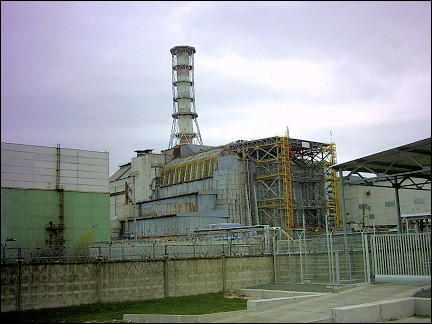
|
After our visit to Kopaci we arrive at reactors 5 and 6, which drives up the geiger count to 175 micro-roentgen. These reactors were still being built during the catastrophe. Reactor 3 was active until 2000. Thousands of people had to work there for years after de disaster.
Eventually we get to a distance of 100 meters from disaster reactor 4, which, according to Dennis, still holds 32 tons of plutonium. The casing, which consists of iron, sand and rock-like stuff, looks rickety and seems about to collapse. I doubt that it still has any protective effect. In 2008 a new sarcophagus will be built around the reactor.
Near a memorial, the geiger counter indicates 550 micro-roentgen. Each step forward I take adds 50 micro-roentgen to the count. It gives the impression that radio activity, as it were, floats in layers in the air, and each step brings you to a new level.
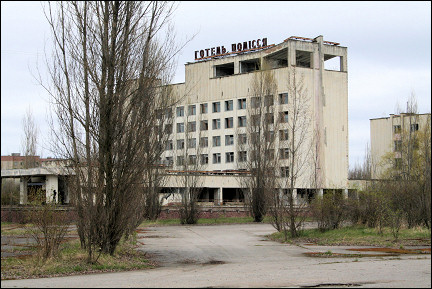
|
After passing another checkpoint, we arrive in Prypiat, approximately 3 km from the reactor. At the time of the disaster 50.000 people lived here, among whom many people who worked in the nuclear plant.
Prypiat is a desolate ghost town now with empty streets, apartment buildings and other buildings. It's weird to walk around in a rather big town where everything is deserted. On the fairground, where in 1986 everything had just been put in place for the annual May 1 celebration, the Ferris wheel and dodgem cars are rusty witnesses of the disaster.
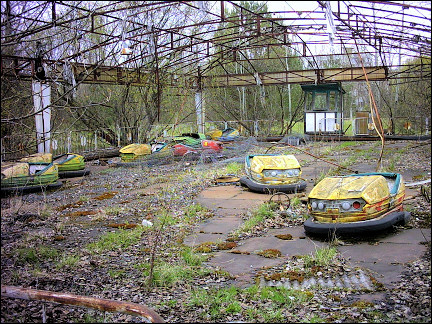
|
Moss, berries and mushrooms apparently absorb radiation. On the fairground, Dennis lays his geiger counter on a tile. It indicates 100 micro-roentgen. Next, he lays geiger counter on a piece of moss: it immediately jumps to 2000 micro-roentgen.
We drive through the Red Wood, which was badly contaminated and turned completely red, up to the needles of the conifers. The actual Red Wood was apparently buried. Meanwhile the wood is growing back, probably newly planted.
Anatoly stops in the middle of the road and Dennis sticks the geiger counter out of the window, after first having set it to measure milli-roentgen. The counter rattles and when the meter indicates over 3000 microroentgen, Dennis quickly pulls in the geiger counter and tells Anatoly to keep driving. In this spot, the counter won't stop before it reaches 10.000 micro-roentgen, according to Dennis.
Since 1996 Chernobyl and Prypiat can be visited by tourists. It apparently isn't a popular attraction: today we only see a bus with schoolchildren from the Ukraine.
On the way to Paryshev we first visit the local store and Dennis asks us to buy something, so the lady who owns the shop can earn a little money. We buy some big bottles of beer and bottled water. Dennis does the same thing and also buys some bread.
We drive on and after a short while we stop on a bridge over the Prypiat river. From the bridge one can see White Russia and Dennis, who wants to smoke a cigaret, takes his time to look around and tell us more fun facts. Like the fact that the cooling water from the reactors was discharged into the Prypiat river, which flows out into the Dnjepr, until 1999.
A sand path with enormous potholes takes us to the hamlet of Paryshev, where currently 14 people have returned. They live in diminutive houses. Some are in a reasonably good state, but others are completele dilapidated. The whole thing looks desolate.
We visit Maria and Mikhail, and old couple who live in a dilapidated house. I ask them how they survived the disaster, Dennis interprets. It turns out Maria left for only three days ans Mikhail didn't leave at all, he refused to go. Now it's 21 years after the accident and both are still alive, albeit that Mikhail squeaks and creaks like an old truck.
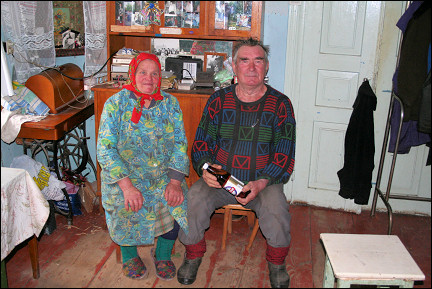
|
Maria is angry with the government for not keeping its promises. Poor people only get a $25 a month "compensation pension". When I ask how these two people live, Dennis says "They own a cow."
A bottle with a tiny bit of vodka appears from the cupboard and is offered to me and Wil. Refusing is not done, but there is so little left in the bottle that we refuse politely. Only after they have offered it three times and we have refused three times, the old people understand that we don't want to finish their last drops of vodka. They want us to take a picture and we oblige. Dennis gives his just bought bread to Maria and a bottle of beer to Mikhail. We also give them our beer and some money.
After our visit we drive back on the sand path and visit the Memorial of Glory, for the victims of the disaster, but also of WWII. In a field next to the memorial sit some tanks and trucks which - according to Dennis - have been cleaned. When we ask how one cleans military vehicles, Dennis, in his wisdom, answers: "That's not possible."
Our last visit is to an 18th century church that was restored in 2004. The government provides buses to make it possible for the few people who meanwhile live here again to visit the church.
After a copious meal that is offered us as a conclusion of our visit to Chernobyl, we say goodbye to Dennis and return to Kiev. When we're just on our way, there already is another checkpoint. We have to get out of the car and stand in some kind of machine. It scans us, we're all "green" and are allowed to continue. After a long drive, Anatoly drops us at the Kiev train station, where we take the train to Lviv.
Lviv
Beautiful buildings around Ploshcha Rynok square
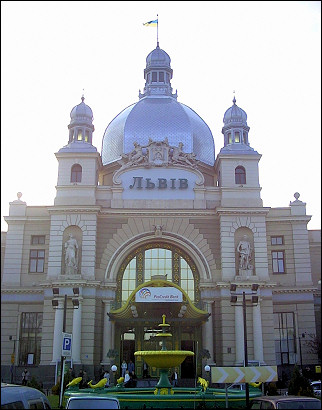
|
Around 8 next morning we arrive in Lviv (in Ukrainian), Lvov (Russian) or Lemberg (German). Lviv has a beautiful city center, paved with cobblestones. There are beautiful buildings around the central Ploshcha Rynok square, with a 19th century city hall, but most buildings could use some paint. In every corner of the square stands a statue of a Greek god: Diana, Neptune, Adonis and Amphitrite.
We take a cab, an ancient Volga, to the Lychakivski cemetary, where 400.000 people are buried. Near the entrance is the grave of Ivan Franko (1856-1916), the national poet. There are graves of other famous Ukrainians and thousands of soldier graves.
The park-like cemetary is divided in sections, in which one finds simple, austere graves next to luxury, pompous tombs. Lychakivski is sometimes called the Père Lachaise of Eastern Europe. Many graves have photos of the deceased and lots of flowers, though often artificial ones.
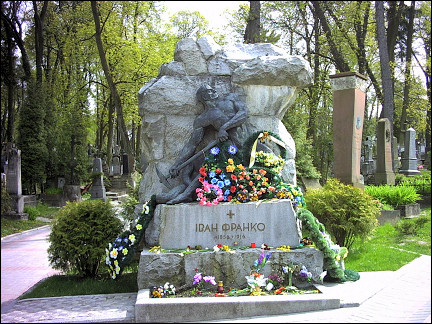
|
We take streetcar # 7 back to the city center, wander around and take a look at the splendid opera house and an orthodox church.
The small bus to Zhovkva, a town near Lviv that we want to visit next day, is full. Two elderly ladies try to sit next to each other, which is not as easy as it sounds. The bench is narrow, the behinds are wide and the shopping bags voluminous. It's an amusing sight, but after a while everything is in position.
At the center of Zhovkva is a square, surrounded by pretty buildings and part of an old fortress wall, which its entrance gate still intact.
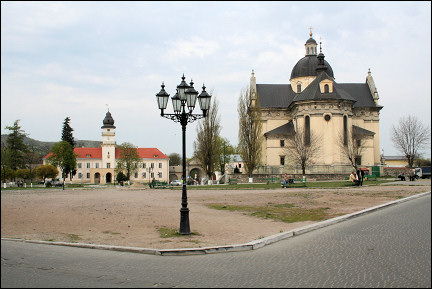
|
After wandering around for a few hours, we take the bus back to Lviv, where we visit the National Museum. It has many icons and old books.
Around Ploshcha Rynok are several museums, but one has to look for them. At number 6 is the Italian House, which has a pretty courtyard. Before we can enter the Renaissance building, we have to put on slippers. We walk on a gorgeous parquet floor with beautiful mosaics. The collection consists of furniture and paintings.
After a cup of coffee we visit the Boims (also: Boyim) chapel. It is a Renaissance chapel with a wonderful black facade, which has lots of carved images. The chapel itself is small, but it has great murals and statues up to the ceiling. The walls are mostly light-blue. The statues seem to follow you with their eyes.
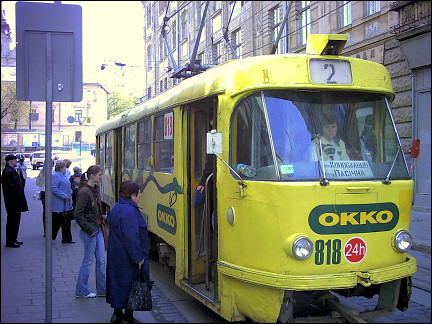
|
Our next visit is to the Arsenal, a museum with a weapons collection from thirty countries. After looking at various pointed, fire, blow and other hand weapons, we visit an indoor market.
Traffic in the Ukraine is chaotic. Everyone honks, no one minds the traffic rules. The gutsiest driver gets right of way. The problem is, many people are equally gutsy, which causes all kinds of congestion. In front of our hotel, a bus hits and destroys a tram's mirror; both drivers get out and curse each other for a couple of minutes, while blocking the road.
We take a cab to Castle Hill. There we have to climb stairs with 255 steps. At the top of the hill, where the castle used to be, is a kind of sun dial which also seems to be a compass. The place has a wonderful view of Lviv.
Back down we have coffee and walk back to the city. The old and on the outside extremely dilapidated Armenian church can't be visited.
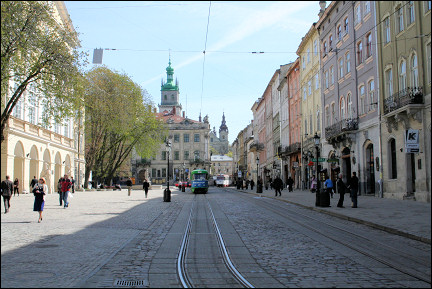
|
In a pharmacy near the central square is the pharmacy museum. The building is not very big, but the museum, which is reached through a door behind the counter, is suprisingly spacious, with a large collection of pharmacy-related objects in several rooms, basements and vaults.
The St. George cathedral is the historical center of the Ukrainian- catholic church. The cathedral, near the statue of Ivan Franko in the Ivan Franko Park, is built with yellow stones and very beautiful inside.
Lviv also has a gorgeous train station. We take the train to Odessa, where we arrive next morning at 8 AM.
Odessa
Tattered concrete and rusty scaffolding along a dirty beach
We walk through a big shopping street and arrive at the harbor. Our first impression of Odessa doesn't make us very happy. As early as it is, there already is a lot of loudly honking traffic and we can taste the exhaust from the cars.
We reach the bottom of a high stairway and wonder if this badly repaired thing could be the world-famous Potemkin stairs, from the film classic Battleship Potemkin, which are used to promote Odessa.
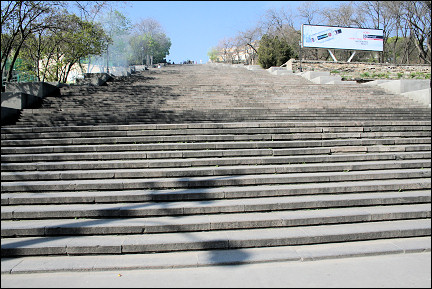
|
I have booked a guide to get to know more about Odessa and the background of this city. Before we arrived, we had high expectations of Odessa. Guide Natalia, a neat woman in her early sixties, picks us up with a chauffeured car at hotel Tsentralnaya.
We drive through the extremely crowded city, take a look at the Potemkin stairs and walk by the beautiful city hall and the just renovated opera house. I have to admit that one can take a wonderful walk from the Potemkin stairs on the promenade along the city hall.
Natalia proposes to take a look at the beach. After a twenty-minutes drive we walk from the French Quarter, on a road which is in a bad condition, down to the beach. Because of the many large tankships, we didn't expect much and our fear is confirmed. A dirty beach with tattered concrete everywhere. There are rusty landings in the water, which also looks filthy.
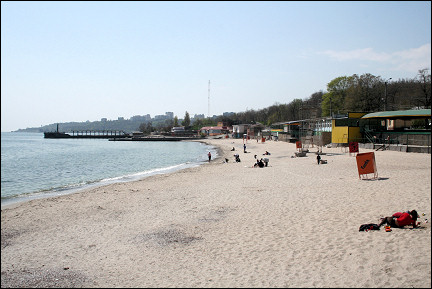
|
Over a cup of coffee Natalia asks us what kind of work we do. When I tell her we work for the government, I see fear in her eyes. From that moment I notice distrust and reserve. She asks Wil if his camera is professional, in a way that is different from normal curiosity.
When Wil walks away from us for a moment, Natalia brings her face close to mine and asks in a conspiratory voice, pointing at a piece of reflecting fabric: "What is that on your coat?" I bend over to her in the same conspiratory way and say: "Reflection." She doesn't believe me at all and suggests we go back to the car. We drive around for a couple of minutes and then Natalia says: "Okay, gentlemen, the tour is finished. Thank you very much."
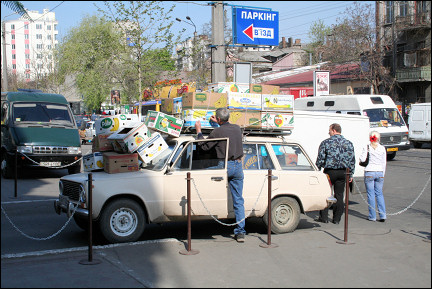
|
We visit the archeological museum of Odessa, which has a collection of antiquities from around the Black Sea: many statues, but also sarcophaguses, skeletons and pots and pans. Remarkable and funny is a Roman statue: authentic after Greek example, the accompanying shield reads.
The museum of literature is housed in a beautiful building. The museum is worth a visit, the adjoining sculpture garden absolutely not.
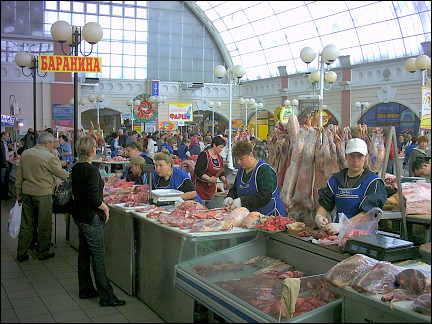
|
On the way to the train station we pass a big indoor meat market. Butchers are hacking and cutting as if their lives depend on it. Cow halves, pigs and sheep hang everywhere. When we leave through the backdoor, we see that the pig halves are transported in regular trailers, without any kind of protection or cooling.
Yalta
A wonderful view of the Black Sea and the Crimean Mountains
At 5 AM we leave train station Simferopol and take the trolley bus. It's the most time-consuming and least comfortable means of transportation to Yalta, but it's only once in a lifetime that one has the opportunity to ride the longest trolleybus trajectory in the world. So we ride into the dark night on the Crimea.
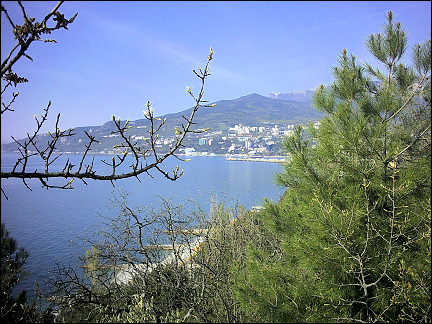
|
Trolleybus 52 takes two and a half hours to cover the 85 km distance from Simferopol to Yalta. Every now and then a loud din sounds inside the old vehicle, and the heating comes on, but it doesn't last long, so it cools off again soon.
When it gets light, we see that the surroundings are gorgeous, high mountains and a view of the Black Sea. At twenty to eight we enter Yalta.
We take a cab and bring our luggage to hotel Yalta, a large building on a hill just outside Yalta. Then an elevator takes us down to a kind of concrete jetway which leads to the Black Sea beach. The view of the sea and the surrounding Crimean Mountains is stunning.
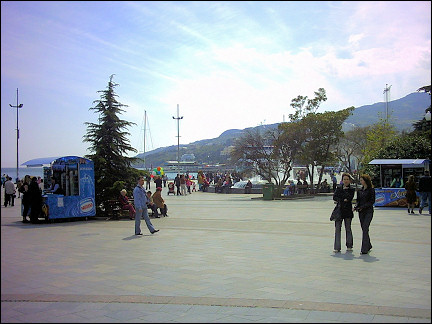
|
In Yalta itself is a wonderful promenade along the sea, where it's pleasantly crowded. Boat trips are offered and there are bars and restaurants. There is a small fair and many people are enjoying the nice weather.
Tour of the Crimea
Czars built castles here through the ages
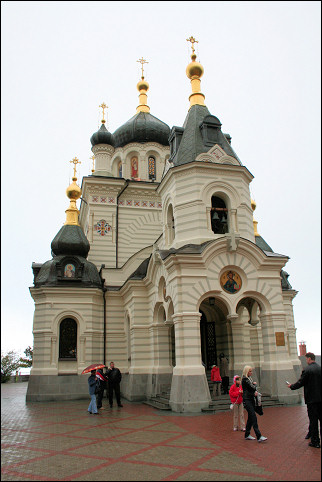
|
Because of the vastness of the Crimea and the many sights, we hire a guide with car to show us the many historical highlights.
We first visit Livadia, a few kilometers west of Yalta. In February 1945 the Yalta conference was held in the Livadia palace, where the British prime minister Winston Churchill, President of the USA Franklin D. Roosevelt and the Russian leader Josef Stalin discussed the fate of Europe after WWII.
The Livadia is one of the many palaces in the Crimea, where, especially in the Yalta region, many czars built their own castles through the ages. The Livadia palace was built in neo-Renaissance style by czar Nicholas II in 1911.
In the czar's billiard room the Yalta treaty was signed, in which Eastern Europe was assigned to the Soviet block and Germany was divided.
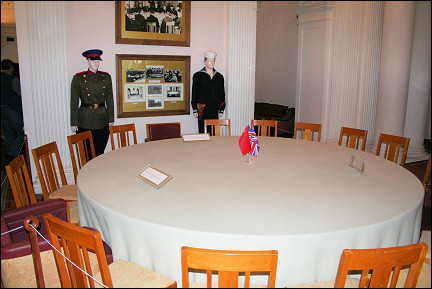
|
On the third floor of the Livadia palace are the living quarters of the Romanovs. Nicholas II's private room, with a Persian carpet of the fireplace, a present from the then Shah of Persia, can be visited.
After the 1917 Russian Revolution the Romanov family was arrested and executed in 1918.
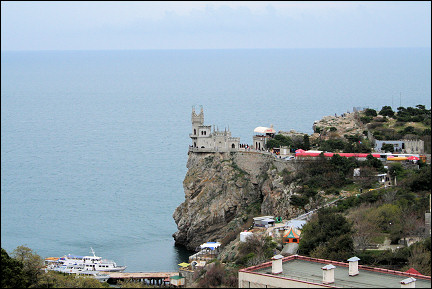
|
We continue our drive through the Crimean Mountains and arrive at the famous Swallownest, a small castle on the edge of a cliff, which isn't as old as it looks. It was built in 1912 by the rich industrialist Shteingel. The castle is surrounded by souvenir stalls and nice to take a look at, but that's it.
We continue our drive and pass underneath the peak of Ay-Petri mountain. The surroundings are beautiful and this high up, the view of the brilliant colors of the Black Sea is really special.
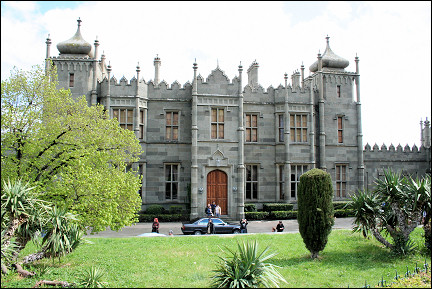
|
After lunch in Simeyiz we visit Count Vorontsov's palace in Alubka. The palace was built with green volcanic rocks and has an odd combination of architectural styles: one the one hand, it looks like a Scottish castle, but on the other it combines Moorish and Russian styles.
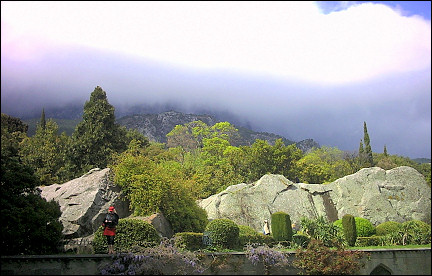
|
The castle is surrounded by pretty French and English gardens and an even more beautiful park. Nothing was too outrageous to realise the park: rocks were blown up and rivers were shifted to create waterfalls; trees and shrubs like magnolias and sequoias were imported from all over the world.
It's raining when we continue our tour to the town of Foros, which became famous after President Gorbatsjov was held prisoner in his own dacha during the 1991 military coup. High up on the mountain is a small church.
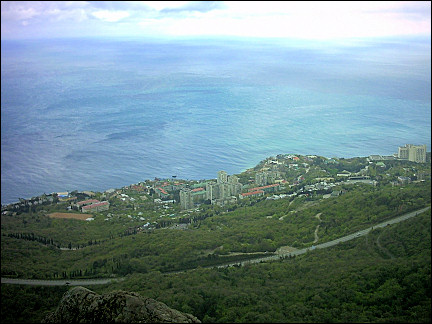
|
We enjoy the view of the Black Sea, noticing strange color effects here, too, while we drive to Balaklava.
Balaklava, which is home to a submarine base, was off limits for visitors until 1996. Balaklava is a beautiful town on a bay in the Black Sea. It is 2500 years old and was in the past a "sub-colony" of Chersonissos. Of the 14th century fortress Jimbala only ruins remain, watching over Balaklava.
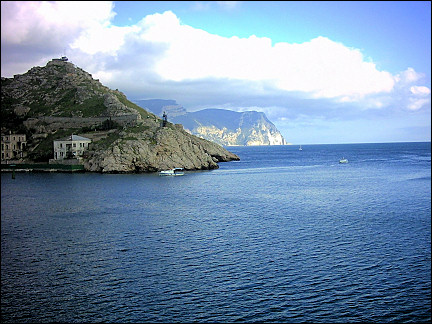
|
We visit a never finished nuclear shelter near the nuclear submarine port, which is hidden in a cave. A tunnel through the mountains, made for the submarines, was one of the few entrance ways to Balaklava.
Florence Nightingale worked here during the Crimean War, in which many British soldiers died, especially in the Valley of Death, which we also visit, during charges of the Light Brigade.
Kiev
Pecherska Lavra has many churches with golden domes
Labor Day (May 1) and the weather is wonderful. We walk to Yalta beach and have a last cup of coffee in the sun. We take a cab to Simferopol, where we catch the train to Kiev, where we arrive, for the second time this trip, early in the morning.
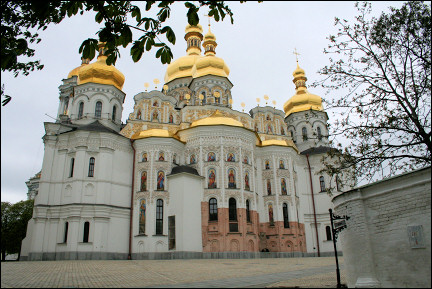
|
In hotel Ukraina we wait until the snowstorm is over. Then we take a cab to Pecherska Lavra, the Cave Monastery of Kiev with 30 kilometers of underground tunnels. Pecherska Lavra is diveded between the state, Upper Lavra, and the church, Lower Lavra.
The huge monastery, founded in 1051, on the edge of the city, has many churches with golden domes and an interesting museum of antiquities, which is housed in several buildings. There also is a library, with all books in Cyrillic, but it's still worth a visit.
We visit an Orthodox church dating from 1116, which has beautiful paintings and statues. Pecherska Lavra is a holy site for pilgrims and it's a good thing we're here early and that it's not a weekend, or else we'd hardly have room to walk.
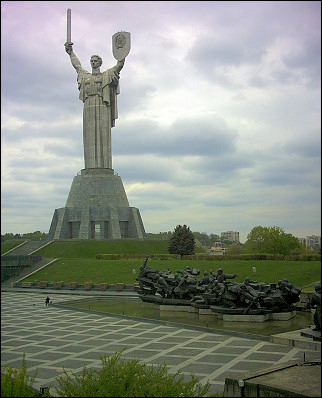
|
We walk on cobblestones to Lower Lavra and buy a candle at a stall, because it's customary, but also because without it, we won't see a thing. I enter the narrow tunnels and before I know what happens, I am eye to eye with the first mummified monk. The monks are behind glass, underneath cloths. From under those cloths, every now and then a pitch-black finger sticks out. Pilgrims sometimes kiss the glass and constantly make the sign of the cross.
When we leave Pecherska Lavra, after three hours of being lost in amazement, we walk to Rodina Mat, "the mother of the nation." The sixty meters high statue has the nickname "tin tits."
Rodina Mat stands on the grounds of the Museum of the Great Patriotic War (WWII), among other statues. Some kind of war music sounds from speakers. The museum exhibits all kinds of airplanes.
Finally, concluding our tour of the Ukraine, we take the subway to Babyn Yar, a ravine where the Nazis dumped over 100.000 inhabitants of Kiev, murdered by them between 1941 and 1943, among whom 34.000 Jews.
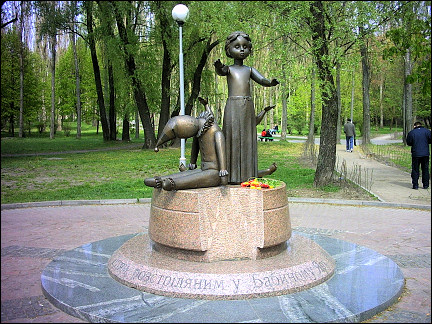
|
Three memorials remind of the massacre: near the subway is a memorial for the murdered children, in the park is a Jewish memorial and on the other side of the road a large Russia memorial.
A comfortable flight back home concludes our vacation. The Ukraine is a beautiful country, which in many places is still poor, but which begins to flourish in the bigger cities. A country with a long history, drenched in suffering.